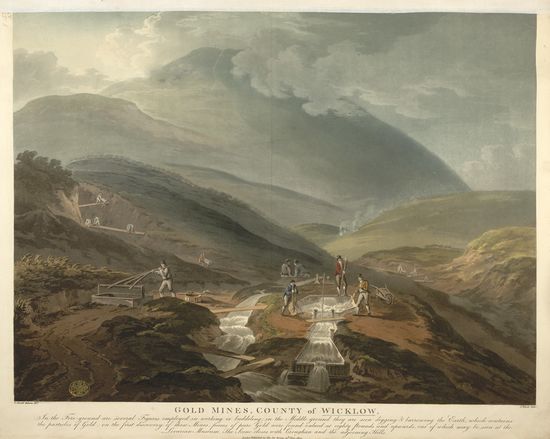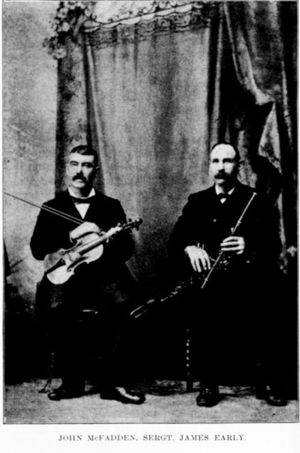Annotation:Miners of Wicklow (The)
X:1 T:Miners of Wicklow, The M:6/8 L:1/8 R:Jig B:Aird - Selection of Scotch, English, Irish and Foreign Airs, vol. 1 (1782, No. 23, p. 9) Z:AK/Fiddler's Companion K:D d|F2A A2=c|BGB AFA|BGE EFG|AFD DED| F2A A2=c|BGB AFA|(B/c/d)B (c/d/e)c|d3 d2:| |:g|fdf fdf|ece ece|fdf fdf|g3 a2g| fdf fdf|ecA ABA|(B/c/d)B (c/d/e)c|d3 d2:|]
MINERS OF WICKLOW, THE ("Na Tocalaide Ua Cill-Mantain" or "Mianairea Cille Meanntain"). AKA and see "Lassie of Gowrie (The)," "Paddy O’Flynn," "Wicklow's March (The)," "Nolan the Soldier." Irish, Double Jig (6/8 time). D Major (Hime. O'Flannagan, O'Neill, Huntingdon): F Major (Bunting). Standard tuning (fiddle). AABB (Hime, O'Flannagan): AA'BB'. Bunting includes the tune as an air in his third volume, The Ancient Music of Ireland (1840), but it was first published in Glasgow by James Aird, in his first volume of Selection of Scotch, English, Irish and Foreign Airs (1782). The tune appears in the mid-19th century music manuscript collection of County Cork uilleann piper and Church of Ireland cleric James Goodman [1]. Uilleann piper Patsy Tuohey recorded the jig in 1919.

The Wicklow Mountains are granite formations formed by the collision of continental plates. As the rock cooled cracks formed, which were filled with mineral dense hot fluids, that eventually formed veins of metal ore. Lead and zinc were the most common ores to be mined, although silver was also extracted. Mines in the Glendalough area date to the 1790's, and soon after Irish Rebellion of 1798 the 1798 a rich vein of lead ore in the Glendasan valley. Aird's publication predates these enterprises, however, so there was obviously mining activity in the Wicklow Mountains prior to this, and in fact, metals have been extracted from the Wicklows since the Bronze age, when copper was the primary ore sought. Lead mines came to the Vale of Avoca in the 1750's [2], and it is perhaps these to which the title refers.


